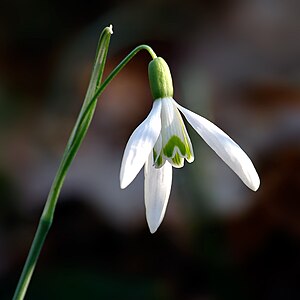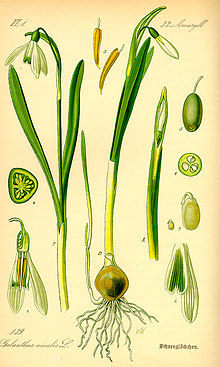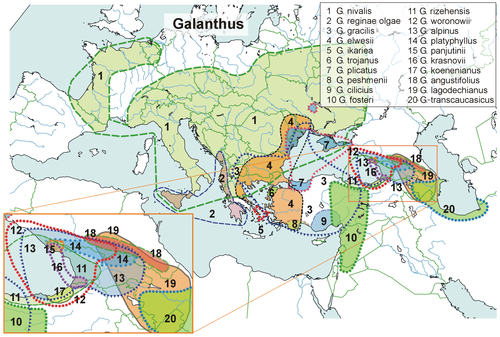Little snowdrop
| Little snowdrop | ||||||||||||
|---|---|---|---|---|---|---|---|---|---|---|---|---|

Common snowdrop ( Galanthus nivalis ) |
||||||||||||
| Systematics | ||||||||||||
|
||||||||||||
| Scientific name | ||||||||||||
| Galanthus nivalis | ||||||||||||
| L. |
The little snowdrop ( Galanthus nivalis ), also called common snowdrop , is a species of the snowdrop ( Galanthus ) genus in the Amaryllis family (Amaryllidaceae). It is the only naturally occurring snowdrop species in Central Europe and the one most commonly seen as an ornamental plant in gardens and parks.
description
Vegetative characteristics
The small snowdrop is a perennial herbaceous plant that usually reaches heights of 7 to 15 (2 to 18) centimeters. This geophyte , which usually grows in troops, forms bulbs 1.5 to 2.5 × 1 to 1.5 (to 2) centimeters in size as survival organs.
The leaves are well developed at the time of flowering, slightly shorter or longer than the inflorescence stem, bluish green or rarely blue-green in color. The leaf blade is linear to ribbon-shaped with a length of 4.5 to 15 (26) centimeters and a width of 0.3 to 0.7 centimeters.
Generative characteristics
The flowers are solitary, nodding on the inflorescence stem. The single flower can be derived from a reduced trugdoldigen inflorescence. There is an overgrown, white-skinned bract sheath, which emerged from the growth of two bracts (called spathe ) and has a length of 2 to 3.5 centimeters. The flower stalk is 1.2 to 3 (to 4) inches long.
The hermaphrodite flowers are threefold. The spreading, outer bracts are elongated to broad obovate with a length of 1.5 to 2 (2.5) and a width of 0.6 to 1.1 centimeters. The coronet-like inclined inner bracts are obovate or oblong with a length of 0.7 to 1.2 and a width of 0.4 to 0.6 centimeters and have a green spot on the outside that does not reach the base. The outer bracts are about twice as long as the inner ones. There are two × three stamens . The 3 to 5 millimeter long anthers open with pores. The ovary has a length of 5 to 6 millimeters and a diameter of 3 to 4 millimeters. The stylus is 6 to 8 millimeters long. The flowering period extends from February to March, sometimes it begins as early as December and lasts until April.
The green, fleshy and spherical capsule fruit containing the seeds opens loculicidal . The light brown seeds are elongated to blunt with a length of 3.5 millimeters and have a fleshy elaiosome .
Chromosome number
The number of chromosomes is 2n = 24, rarely 26.
ecology
The little snowdrop is a typical spring plant in which even the flowers are frost hardy . The leaves of this onion - geophytes draw at an early stage and are therefore already in early summer gone.
In terms of flower biology, it is a homogeneous “bluebell with scattering device”, with sugary “drilled tissue” and with nectar . The white flower color is caused by the inclusion of air between the cells. The inner bracts have a stronger scent than the outer ones and thus serve to orient the pollinators. The pollen trickles down onto the clinging bees and butterflies. Because of their strong UV reflection, the flowers stand out clearly from the background for visitors even when there is snow. Most pollinators are honey bees , which are particularly interested in pollen, and butterflies . Self-pollination takes place before withering .
The seeds have a curved appendage ( elaiosome ), which is used by ants to spread ( myrmecochory ). As a special adaptation to this form of expansion, the sagging fruit stalks sink to the ground.
Toxicity
The little snowdrop is poisonous. The main amount of toxins is in the onions. There are 0.09% alkaloids such as galanthamine and lycorine .
Diseases
The snowdrop is attacked by the rust fungi Melampsora galanthi-fragilis with spermogonia and aecidia and Puccinia galanthi with telia .
Occurrence
The little snowdrop occurs in France, Italy, the Balkans, Austria and Switzerland, in southwest Germany, in southern Poland and in western Ukraine in deciduous forests at altitudes of mostly 300 to 600 (100 to 1400) meters. It is preferred to be found on lime. This species was naturalized in northern Central Europe and North America.
It likes to thrive socially in alluvial forests and damp mixed deciduous forests on seep-moist, nutrient-rich, mild-moderately acidic, humus-rich, deep, loose clay and loam soils. It is a cheesecloth and partial shade plant. It occurs particularly in societies of the Alno-Ulmion ( hardwood meadow ), but also in the Fagetalia ( red beech forest ) and Quercetalia pubescentis ( downy oak forest ) .
Systematics
There are intermediate forms of Galanthus nivalis with Galanthus reginae-olgae in Italy and in the Balkans and with Galanthus plicatus subsp. byzantine in northwestern Turkey.
use
The little snowdrop is widely used as an ornamental plant in gardens and parks. It has become overgrown and naturalized, especially in old orchards and church yards. The species has been in culture since 1568 at the latest. There are numerous varieties (selection):
- 'Atkinsi' (possibly a hybrid with Galanthus plicatus ): one or both leaf margins are slightly folded back. The flowering period extends from January to February. The outer bracts are very long and one thing is often different.
- 'Imperati': flowers and leaves are larger. The leaf margin is more or less rolled back, but not folded back.
- 'Scharlockii': The bracts are leaf-like.
- 'Flore Pleno': The flowers are double. The variety has been known since 1733.
Common names
The other German-language trivial names exist or existed for the Little Snowdrop : Apralleblämcher ( Transylvania ), witte Fiolen, Gaisglöckli ( St. Gallen ), white horny flower, maiden in a shirt, Märtenblome ( East Friesland ), Märzaglöggli ( Lucerne , Bern , St. Gallen ) March Glöckle ( Memmingen ), snow flowers ( Silesia ) snowflakes (Silesia), Schneegaken (Silesia), snow Gallen (Silesia), snowdrop ( Weser , Tirol ) Schneeglöckli (Bern, St. Gallen), Schneekaterl ( Salzburg , Linz ) Schneetröpfle (Memmingen), Schneetröpfle ( Lauban , Thuringia , Frankfurt an der Oder ), Schneeweilen, Schubleemen (Transylvania), Schaiklehkeltscher (Transylvania), Sneeklocke ( Unterweser ), Swalenswyppesblome, naked, witte Wiefke (East Friesland) and real timeless (St. Gallen) in the Rhine Valley).
supporting documents
- GBStraley & FHUtech: Galanthus Galanthus nivalis , p. 280 - online with the same text as the printed work , In: Flora of North America Editorial Committee (ed.): Flora of North America North of Mexico. , Volume 26, Magnoliophyta: Liliidae: Liliales and Orchidales. , Oxford University Press, New York a. a. 2002, ISBN 0-19-515208-5 (section description)
- Eckehart J. Jäger, Friedrich Ebel, Peter Hanelt, Gerd K. Müller (eds.): Rothmaler excursion flora from Germany. Volume 5: Herbaceous ornamental and useful plants . Spectrum Academic Publishing House, Berlin Heidelberg 2008, ISBN 978-3-8274-0918-8 .
- Ruprecht Düll , Herfried Kutzelnigg : Pocket dictionary of plants in Germany and neighboring countries. The most common Central European species in portrait . 7th, corrected and enlarged edition. Quelle & Meyer, Wiebelsheim 2011, ISBN 978-3-494-01424-1 . (Section ecology)
- Roth / Daunderer / Kormann: Poisonous plants, plant poisons. 6th edition (2012) ISBN 978-3-86820-009-6
- Entry at GRIN.
Individual evidence
- ↑ a b c d e f g h i j G.B.Straley & FHUtech: Galanthus Galanthus nivalis , p. 280 - same text online as the printed work , In: Flora of North America Editorial Committee (ed.): Flora of North America North of Mexico . , Volume 26, Magnoliophyta: Liliidae: Liliales and Orchidales. , Oxford University Press, New York a. a. 2002, ISBN 0-19-515208-5
- ^ Tropicos
- ↑ Galanthus nivalis, G. elwesii and G. woronowii - Snowdrop (Amaryllidaceae) - Plant portrait (PDF; 7.2 MB). Website of the Bochum Botanical Association. Retrieved December 10, 2017.
- ↑ Peter Zwetko: The rust mushrooms Austria. Supplement and host-parasite directory to the 2nd edition of the Catalogus Florae Austriae, III. Part, Book 1, Uredinales. (PDF; 1.8 MB).
- ^ Erich Oberdorfer : Plant-sociological excursion flora for Germany and neighboring areas . With the collaboration of Angelika Schwabe and Theo Müller. 8th, heavily revised and expanded edition. Eugen Ulmer, Stuttgart (Hohenheim) 2001, ISBN 3-8001-3131-5 , pp. 138 .
- ^ Georg August Pritzel , Carl Jessen : The German folk names of plants. New contribution to the German linguistic treasure. Philipp Cohen, Hannover 1882, p. 157, archive.org
Web links
- Little snowdrop. In: FloraWeb.de.
- Little snowdrop . In: BiolFlor, the database of biological-ecological characteristics of the flora of Germany.
- Profile and distribution map for Bavaria . In: Botanical Information Hub of Bavaria .
- Galanthus nivalis L., map for distribution in Switzerland In: Info Flora , the national data and information center for Swiss flora .
- Thomas Meyer: Data sheet with identification key and photos at Flora-de: Flora von Deutschland (old name of the website: Flowers in Swabia )
- Plant portrait Galanthus nivalis, G. elwesii and G. woronowii - snowdrops (Amaryllidaceae), by Corinne Buch and Armin Jagel. Bochumer Botanischer Verein eV
- The ingredients of the snowdrop
- Galanthus nivalis inthe IUCN 2013 Red List of Threatened Species . Posted by: Crook, V. & Davis, A., 2008. Retrieved April 28, 2014.



